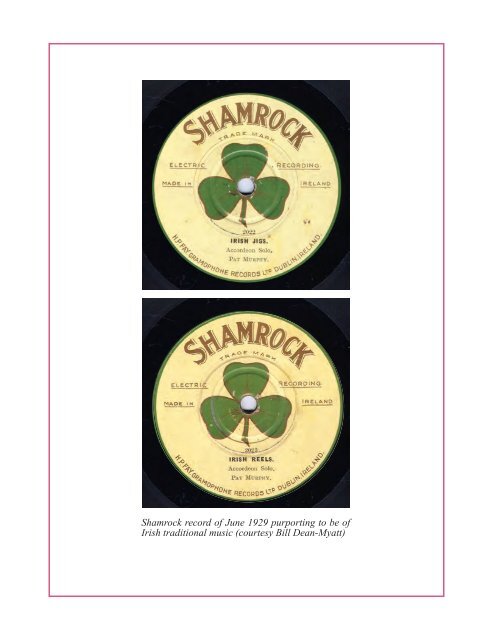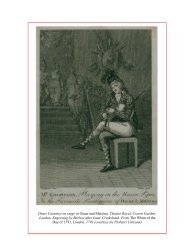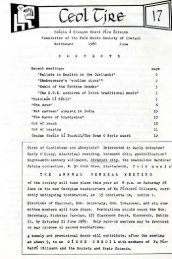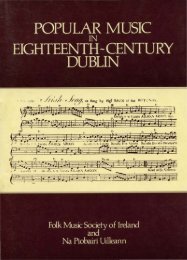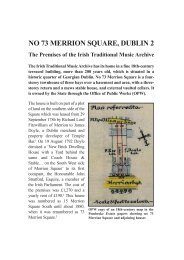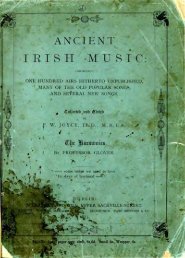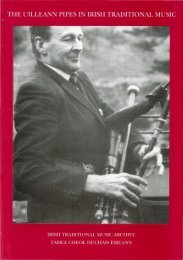Union Pipes - Irish Traditional Music Archive
Union Pipes - Irish Traditional Music Archive
Union Pipes - Irish Traditional Music Archive
Create successful ePaper yourself
Turn your PDF publications into a flip-book with our unique Google optimized e-Paper software.
Shamrock record of June 1929 purporting to be of<br />
<strong>Irish</strong> traditional music (courtesy Bill Dean-Myatt)
SHAMROCK RECORDS: THE FIRST IRISH-MADE<br />
COMMERCIAL DISCS 1928–1930<br />
Nicholas Carolan, <strong>Irish</strong> <strong>Traditional</strong> <strong>Music</strong> <strong>Archive</strong>, Dublin<br />
Version 1.0 as at 14 November 2012 1<br />
While sound recording has been carried out in Ireland since 1878,<br />
when the first tinfoil-cylinder machines were introduced, 2 no<br />
commercial recordings were manufactured in the country for the first<br />
fifty years of the medium’s existence. <strong>Irish</strong> performers went to Britain<br />
to be recorded, or British companies came to Ireland on brief recording<br />
excursions, but the resulting cylinders and discs were made in<br />
Britain. It was as late as 1928 before an attempt was made to set up<br />
an <strong>Irish</strong> manufacturing company. This attempt, like many another in<br />
the still young industry, was accompanied by a measure of sharp<br />
practice. In time it was to be revealed as an episode in the chequered<br />
business and criminal career of one of its principals.<br />
H.P. Fay Gramophone Records Ltd was registered as a new private<br />
company in the <strong>Irish</strong> Free State on 11 December 1928 with nominal<br />
capital of £1,000 in shares of £1. The first directors were two subscribers<br />
of 500 shares each: Arthur William Greenhill, Pontifex House,<br />
Shoe Lane, London, director of Greenhill & Sons Ltd, London; and<br />
Hugh Patrick Fay of the same address, engineer. Greenhill was British,<br />
Fay <strong>Irish</strong>. The registered office was at 28A Arran Quay, Dublin. 3<br />
1<br />
More relevant information on Shamrock Records will emerge in the future, and<br />
the article will be updated here to include such information as it is found. The<br />
essay should be cited by author, title, version and date on www.itma.ie as above.<br />
Additions can be sent to shamrock.records@itma.ie.<br />
2<br />
Nicholas Carolan, ‘The Talking Machine Comes to Ireland’, in Dear Far-Voiced<br />
Veteran: Essays in Honour of Tom Munnelly, ed. Anne Clune, Old Kilfarboy<br />
Society, Co Clare, 2007: 73–83.<br />
3<br />
Public Record Office – now National <strong>Archive</strong>s of Ireland – file 7812 D; The <strong>Irish</strong><br />
Times, Dublin, 21 Dec. 1928: 11.
SHAMROCK ReCORDS: THe FIRST IRISH-MADe COMMeRCIAL DISCS 1928–1930 2<br />
The main business of Greenhill & Sons was the manufacture of<br />
accessories for the motor and cycle trade, 4 but Arthur William<br />
Greenhill had a personal interest in sound recording and in May 1928<br />
had applied for a patent for ‘improvements in or relating to talkingmachine<br />
sound-record members, such as disks, and methods of<br />
making the same’. 5 He was doubtless a son of the J.e. Greenhill who<br />
in 1891 patented the ‘Greenhill Mechanical Phonograph Motor’,<br />
which was manufactured in London. 6<br />
Hugh Patrick Fay was an ‘American engineer and businessman’ who<br />
had been ‘born and reared in Donabate’, Co Dublin. 7 <strong>Irish</strong> census<br />
records for 1901 and other sources show that he was born in 1889.<br />
He was, in the census year, still at school and living in Ballalease<br />
West, Donabate, Co Dublin, the only son and middle child of three<br />
children born to Mathew Fay, a seemingly prosperous farmer originally<br />
from Co Cavan, and his wife Margaret. 8 In 1904, at the age of<br />
15, Fay emigrated to New York. 9 As the <strong>Irish</strong> partner of the new company,<br />
he would go on to handle publicity in Dublin and be its public<br />
face. He told newspaper reporters that he had been ‘associated for<br />
4<br />
The British Motor & Cycle Standard Catalogue, The Standard Catalogue Co Ltd,<br />
London, [1923–5]: 5, 22. Celluloid was the main component of the company’s<br />
products.<br />
5<br />
espacenet patent search at http://worldwide.espacenet.com, accessed 8 Aug. 2012.<br />
6<br />
George Frow, ‘Prime Mover’, Hillandale News, London, no 72, Apr. 1973:<br />
38–41; ‘The December 2000 and April 2001 Sales, Revisited’, Hillandale News,<br />
no 236, Winter 2001–2002: 432.<br />
7<br />
<strong>Irish</strong> Independent, Dublin, 9 Jan. 1929: 9.<br />
8<br />
www.census.nationalarchives.ie, accessed 4 Aug. 2012. From the census records<br />
alone he could also have been born in 1890, but a variety of other sources quoted<br />
below confirm the date of 1889. The 1911 census records show only the parents<br />
living on the family farm.<br />
9<br />
‘Passenger Lists leaving UK 1890–1960’, accessed via www.findmypast.ie, 31 Oct.<br />
2012. This source confirms his date of birth as 1889 and classifies him as a labourer.
3<br />
SHAMROCK ReCORDS: THe FIRST IRISH-MADe COMMeRCIAL DISCS 1928–1930<br />
years with the gramophone trade and [had] travelled extensively in<br />
Germany, America, and Japan’. 10<br />
Hugh Patrick Fay had indeed been associated for some years with<br />
the gramophone trade. In New York in 1921, when he was in his early<br />
thirties and head of sales and distribution for the<br />
Siemon Hard Rubber Company, 11 he<br />
had also become ‘President and<br />
Managing Director’ of the shortlived<br />
Gaelic Phonograph Record<br />
Co. This had its offices first at<br />
637 Madison Avenue, a<br />
prestigious-sounding address, 12<br />
and it advertised 31 doublesided<br />
discs for sale in the November<br />
of that year, including<br />
recordings of songs in the <strong>Irish</strong><br />
language. 13 The artists were mostly <strong>Irish</strong>born:<br />
popular and semi-classical singers, ‘<strong>Irish</strong> tenors’ among them;<br />
and traditional instrumentalists whose recordings are still sought<br />
after, such as the piccolo player P.J. McNamara of Limerick city, the<br />
accordion player Patrick J. Conlon of Co Galway, and the<br />
10<br />
Evening Herald, Dublin, 17 July 1929: 1.<br />
11<br />
Allan Sutton & Kurt Nauck, American Record Labels and Companies: An<br />
Encyclopedia (1891–1943), Mainspring Press, Denver, Colorado, 2000: 283.<br />
12<br />
Google tells us that the School of American Ballet was founded by George<br />
Balanchine at that address in the 1930s.<br />
13<br />
The Gaelic American, New York, 5 Nov. 1921: 2; 12 Nov. 1921: 2; 19 Nov. 1921:<br />
2. I am obliged to my colleague Harry Bradshaw for these leads to Hugh Patrick<br />
Fay’s earlier adventures in the record trade. My recounting of the Smithfield-<br />
Shamrock story to him triggered his memory of Fay’s involvement in <strong>Irish</strong>-<br />
American sound recording in New York and a donation of the appropriate<br />
references.
SHAMROCK ReCORDS: THe FIRST IRISH-MADe COMMeRCIAL DISCS 1928–1930 4<br />
Chicago-born uilleann piper Tom ennis. In spite of such a fullblooded<br />
start, and at least three more issues, 14 the company quickly<br />
ran into difficulties. It moved to 40 West 57th Street in February<br />
1922, and Fay was replaced as managing director in the following<br />
month. 15 In March 1923 Gaelic filed for bankruptcy. 16<br />
Six years later, in Dublin, the new Fay Gramophone registration was<br />
quickly followed up in early 1929 with the exciting news that the<br />
company had acquired premises in Smithfield, in north central<br />
Dublin, and that plant had been installed for the manufacture of<br />
gramophone records. The making of celluloid fancy goods and toys,<br />
and gramophones and radios, was also envisaged. Operations were<br />
to start on 1 February, and it was hoped that some 250 people would<br />
eventually be employed. It was proposed to produce 8-inch records<br />
for sale at 1/3 each and 10-inch records for 2/6. According to Fay,<br />
the project would involve an outlay of £20,000, and it was intended<br />
that the factory would eventually produce 6,000 records a day. 17 A<br />
company premises seems also to have been opened at no 36 Pearse<br />
St in south central Dublin, a shopfront premises which was called<br />
‘Shamrock Gramophone House’ from 1928. 18<br />
The Fay company advertised for a sales manager in April 1929, 19 and<br />
by June it was reported that 1,000 copies of each of fifteen records<br />
14<br />
Talking Machine World, New York, Mar. 1922: 159.<br />
15<br />
Talking Machine World, Mar. 1922: 155.<br />
16<br />
Sutton & Nauck: 85, 283.<br />
17<br />
<strong>Irish</strong> Independent, 9 Jan. 1929: 9. The premises was a ‘former skin and hide store’.<br />
There were several such on Smithfield and it has not been possible to identify the<br />
Shamrock premises.<br />
18<br />
Thom’s Official Directory of Ireland for the Year 1928, Alex. Thom & Co., Dublin,<br />
1928: 2062. The entry also appears in the issues for 1929, 1930 and 1931, but not<br />
subsequently. Strangely, none of the issues gives an address for H.P. Fay Ltd or<br />
Shamrock Records in Smithfield.<br />
19<br />
The <strong>Irish</strong> Times, 25 Apr. 1929: 1.
5<br />
SHAMROCK ReCORDS: THe FIRST IRISH-MADe COMMeRCIAL DISCS 1928–1930<br />
From Ireland’s Own, Wexford, 20 July 1929
SHAMROCK ReCORDS: THe FIRST IRISH-MADe COMMeRCIAL DISCS 1928–1930 6<br />
had been distributed. 20 They were produced on a ‘Shamrock’ label, 21<br />
and they had been pressed, it was said, from ‘mother’ records made<br />
in America. Negotiations were in progress for the building of a studio<br />
in Findlater House at 50 O’Connell Street, Dublin, for the purpose of<br />
recording local artists. A ready demand was expected for these records<br />
in Ireland and in America with its 30,000,000 <strong>Irish</strong> ‘kith and kin’. 22<br />
The new company was evidently aware of the strong contemporary<br />
interest in <strong>Irish</strong> traditional culture and its collection, an interest that<br />
had led to the formation of the Folklore of Ireland Society in 1927<br />
and would lead to the <strong>Irish</strong> State’s creation of the <strong>Irish</strong> Folklore<br />
Commission in 1935. Over the next few months <strong>Irish</strong> folklore and<br />
music, and songs, jigs, reels and marches were to be put on records<br />
in Dublin and disseminated around the world, according to Fay, and<br />
a select party was to explore the remotest parts of Ireland in search<br />
of the ‘true Gaelic culture’. 23 By July 1929 he was claiming that he<br />
was about to begin ‘an extensive Tour of Ireland with our Recording<br />
Van, making tests of <strong>Traditional</strong> <strong>Irish</strong> <strong>Music</strong> to be submitted to our<br />
<strong>Music</strong>al Director, and our Permanent Recording Studios and Band<br />
Rooms will Open at 28 Upper O’Connell St. in a fortnight’s time’.<br />
He also issued a warning about a non-<strong>Irish</strong> ‘recording apparatus’ that<br />
had been touring the country in search of <strong>Irish</strong> talent. 24<br />
20<br />
<strong>Irish</strong> Independent, 15 June 1929: 6.<br />
21<br />
As might be expected, there have been several other Shamrock labels in existence<br />
over the decades, some of them 78 labels of the name published in <strong>Irish</strong> America<br />
in the 1920s and 1950s, and at least one a microgroove label published in Ireland<br />
in the 1960s and 1970s.<br />
22<br />
Evening Herald, 17 July 1929: 1. No mention of Shamrock Records has been<br />
found in the contemporary <strong>Irish</strong>-American press.<br />
23<br />
Evening Herald, 17 July 1929: 1.<br />
24<br />
<strong>Irish</strong> Independent, 3 July 1929: 5. This rival operation was doubtless that of the<br />
Parlophone Company of London which had come on the first of two productive<br />
recording trips to Ireland in mid-1929 (see www.itma.ie/digitallibrary). The<br />
resulting records were manufactured in Britain.
7<br />
SHAMROCK ReCORDS: THe FIRST IRISH-MADe COMMeRCIAL DISCS 1928–1930<br />
From <strong>Irish</strong> Independent,<br />
Dublin, 3 July 1929
SHAMROCK ReCORDS: THe FIRST IRISH-MADe COMMeRCIAL DISCS 1928–1930 8<br />
An option had been taken by Fay on a factory in Rathmines, it was<br />
reported, for the future manufacture of gramophones and radios. 25<br />
Young employees, including a ‘dozen pretty girls’, had been trained<br />
by experts from england. Twenty-five thousand discs of the June<br />
1929 issue had been made on the company’s eight pressing<br />
machines. 26<br />
Surviving copies show that Shamrock records were 10" double-sided<br />
discs. A large green gold-edged shamrock featured as a central logo,<br />
and lettering was in gold and black on a cream background, all<br />
suggestive of the <strong>Irish</strong> national flag. They were issued by ‘H.P. Fay<br />
Gramophone Records Ltd., Dublin, Ireland’, and were, the labels proclaimed,<br />
the product of ‘electric recording’ and ‘made in Ireland’.<br />
Local dealers began to advertise the new records: ‘McHugh’s have<br />
the new Dublin-made “Shamrock Records”. Come and hear the first<br />
<strong>Irish</strong>-made records at 59 Talbot St. (at the Bridge) [Dublin]’. 27<br />
Provincial agents were appointed: ‘Sheridan’s Gramophone Stores,<br />
Ceannanus Mór [Kells, Co Meath]... We are also Agents for the New<br />
<strong>Irish</strong>-made “SHAMROCK” Records’. 28 Three hundred dealers<br />
throughout Ireland were said to be carrying the records. 29<br />
25<br />
Another company – ‘Orchestraphone Company Ltd’ – was registered by Fay and<br />
Greenhill for the making of gramophone records and gramophones on 25 Mar.<br />
1929 with nominal capital of 100 £1 shares. Both gave their address as the<br />
Gresham Hotel, one of Dublin’s leading hotels. This company was also involved<br />
in experimentation with sound for film, and gave a ‘synchronised sound films’<br />
trade-show demonstration in the Stella Cinema, Rathmines, Dublin, in Apr. 1929.<br />
The demonstration was only partially successful, perhaps because of the physical<br />
limitations of the cinema (<strong>Irish</strong> Independent, 9 Apr. 1929: 10). This company<br />
was dissolved by the Registrar of Joint Stock Companies on 28 Aug. 1931<br />
(Public Record Office – now National <strong>Archive</strong>s of Ireland – file 7850 D).<br />
26<br />
Evening Herald, 17 July 1929: 1; Ireland’s Own, Wexford, 20 July 1929: 62.<br />
27<br />
<strong>Irish</strong> Independent, 25 June 1929: 14.<br />
28<br />
The Meath Chronicle, Navan, 10 Aug. 1929: 3.<br />
29<br />
Evening Herald, 17 July 1929: 1.
9<br />
SHAMROCK ReCORDS: THe FIRST IRISH-MADe COMMeRCIAL DISCS 1928–1930<br />
From <strong>Irish</strong> Independent, Dublin, 1 July 1929<br />
Newspapers greeted the discs uncritically: they were ‘superb<br />
records’, a ‘triumph of skill in <strong>Irish</strong> manufacture’, and ‘everything<br />
in connection with the records is <strong>Irish</strong>, including the wrappers and<br />
printing’, according to the Evening Herald of Dublin. 30<br />
It is not known for certain what records were available by June 1929,<br />
but they included the discs<br />
S2004 &<br />
S2005<br />
S2014 &<br />
S2015<br />
S2018 &<br />
S2019<br />
Doreen McCoy: Where Have You Been All My Life? Foxtrot<br />
Song (“Lucky Girl”). (Robin, Furber, Charig); Is There<br />
Anything Wrong with That? (H. Magidson, M.H. Cleary)<br />
Seamus O’Brien, vocal: The Soldier’s Song; My Dark<br />
Rosaleen<br />
<strong>Irish</strong> Soldiers’ Band: Moore’s Melodies Selection;<br />
Dear Little Shamrock Selection<br />
30<br />
Issue of 5 July 1929: 5.
SHAMROCK ReCORDS: THe FIRST IRISH-MADe COMMeRCIAL DISCS 1928–1930 10<br />
S2022 &<br />
S2023<br />
S2029<br />
Pat Murphy, accordion, with piano: <strong>Irish</strong> Jigs; <strong>Irish</strong><br />
Reels<br />
Michael O’Connell, with piano accompaniment: The<br />
Hills of Donegal. <strong>Irish</strong> song. (P.J. O’Reilly, W.<br />
Sanderson); Jere Conway: Danny Boy 31<br />
The Shamrock July 1929 list, according to a newspaper<br />
advertisement from the company, consisted of twelve issues in an S<br />
series which was now using a single catalogue number for each disc,<br />
and included discs that did not purport to be <strong>Irish</strong> but were of what<br />
would have then been called ‘jazz music’:<br />
S2030<br />
S2031<br />
S2032<br />
S2033<br />
S2034<br />
Shamrock Concert Orchestra: Bohemian Girl (overture;<br />
Balfe); Wine, Women and Song (waltz; Strauss)<br />
Shamrock Concert Orchestra: Blue Danube (waltz;<br />
Strauss); Light Cavalry (overture; Suppé)<br />
Seamus O’Leary, tenor: Yes! Let Me like a Soldier Fall<br />
(‘Maritana’; Wallace), matrix 132A; Andy Doyle,<br />
baritone: The Floral Dance (K. Moss), matrix 133A<br />
Seamus O’Leary, tenor, with orchestra: There is a<br />
Flower that Bloometh (‘Maritana’; Wallace); Andy Doyle,<br />
baritone, with orchestra: The Bandolero (Leslie Stuart)<br />
James McDonnell, tenor, & male chorus: Take a Pair<br />
of Sparkling eyes (‘The Gondoliers’; Sullivan); Tony<br />
O’Moore, tenor: The Old Rustic Bridge by the Mill<br />
31<br />
Listed for sale on www.offtherecord.ie, 27 Sept. 2012.
11<br />
SHAMROCK ReCORDS: THe FIRST IRISH-MADe COMMeRCIAL DISCS 1928–1930<br />
S2035<br />
S2036<br />
S2037<br />
S2038<br />
S2039<br />
S2040<br />
S2041<br />
Seamus O’Reilly, tenor: eily Mavourneen (‘Lily of<br />
Killarney’; Benedict), matrix 135A; Denis Forde,<br />
tenor: Molly Bawn (Lover), matrix 135B<br />
Dan Hynes, Ireland’s premier xylophone player: My<br />
<strong>Irish</strong> Lass (jig; W. Whitlock); Mac’s Birthday (jig; W.<br />
Whitlock)<br />
<strong>Irish</strong> Soldiers’ Band: Colonel Bogey (march; Alford);<br />
O’Flanagan Brothers, accordion duet: La Paloma<br />
(Tradier)<br />
<strong>Irish</strong> Soldiers’ Band: el Capitan (march; Sousa);<br />
O’Flanagan Brothers, accordion duet: Blaze Away<br />
(march; Holzmann)<br />
Bill Johnstone, Chicago’s Black-Faced Star: There’s<br />
a Rainbow round My Shoulder (Jolson, Rose, Dryer);<br />
Old Man Sunshine (Dixon & Warren)<br />
Plaza Dance Band: Glad Rag Doll (foxtrot; Yeller,<br />
Ager, Dougherty); The Novelty Dance Orchestra:<br />
Beloved (waltz; Kahn & Sanders)<br />
Plaza Dance Band: Just a Night for Meditation (foxtrot;<br />
Lewis, Young & Pollack); The Novelty Dance<br />
Orchestra: King for a Day (waltz; Lewis, Young &<br />
Fiorito) 32<br />
32<br />
<strong>Irish</strong> Independent, Dublin, 1 July 1929: 10, and from discs in the collection of the<br />
<strong>Irish</strong> <strong>Traditional</strong> <strong>Music</strong> <strong>Archive</strong>. Additional composer etc. information has been<br />
supplied from Karlo Adrian & Arthur Badrock eds, Edison Bell Winner Records<br />
(second, revised edition; with history of Winner by Frank Andrews), e. Bayly,<br />
Bournemouth, 1989: passim; and from Bill Dean-Myatt, pers. comm., Aug. 2012.
SHAMROCK ReCORDS: THe FIRST IRISH-MADe COMMeRCIAL DISCS 1928–1930 12<br />
All the ‘<strong>Irish</strong>’ artists are otherwise unknown by name, and it is certain<br />
that the original recording artists (who were not <strong>Irish</strong>) were all given<br />
hibernian pseudonyms by the company to make them more attractive<br />
to its target audience. Since the original recordings were said to have<br />
been made in America, it could be believed that they were recorded<br />
by <strong>Irish</strong>-American performers who were unknown in the homeland.<br />
The ‘O’Flanagan Brothers’ were doubtless meant to give the<br />
impression of being the Flanagan Brothers, a genuine and successful<br />
Waterford family group of recording artists in 1920s <strong>Irish</strong> America,<br />
one that may have recorded earlier for Fay’s Gaelic Phonograph<br />
Company in New York. 33<br />
The chicanery did not end there. Most of the masters were recorded<br />
not in America, as stated, but in england by the edison Bell Company<br />
of London, and it is certain that not all of them were electrically<br />
recorded. 34 On the evidence of identity of repertory, and similarity of<br />
instrumentation, vocal category, disc pairings, issue dates, etc., many<br />
of the Shamrock artists are to be found on the Winner label of edison<br />
Bell, and some on its Velvet Face label. The ‘O’Flanagan Brothers’<br />
are revealed to be the Macari Brothers, a London piano-accordion<br />
duet whose recordings of ‘La Paloma’ and ‘Blaze Away’ were released<br />
on Winner disc 4790 in March 1928. ‘Doreen McCoy’ must be the<br />
American comedienne Beth Challis on Winner 4872 and Winner<br />
33<br />
For the Flanagans, see the Viva Voce CD Tunes We Like to Play on Paddy’s Day<br />
(VIVAVOCe007, Dublin, 1996).<br />
34<br />
The following analysis is based on Adrian & Badrock 1989. edison Bell did reissue<br />
some discs from such American labels as Paramount, Gennett and Domino, and it<br />
is just possible that some of these appeared on Shamrock. I am grateful to Bill<br />
Dean-Myatt for suggesting possible Winner sources for Shamrock Records and<br />
supplying me with his research notes. electrical recording was first introduced by<br />
the record industry in America in 1924–25; and the first electrical Winner recording<br />
was issued in Apr. 1926 (Adrian & Badrock 1989: [4]).
13<br />
SHAMROCK ReCORDS: THe FIRST IRISH-MADe COMMeRCIAL DISCS 1928–1930<br />
Shamrock 2022 and its acoustic original of 1914:<br />
Edison Bell Winner 2582 (courtesy Bill Dean-Myatt)
SHAMROCK ReCORDS: THe FIRST IRISH-MADe COMMeRCIAL DISCS 1928–1930 14<br />
4879, both issued in February 1929. ‘Seamus O’Brien’ may be a<br />
composite of baritone Seamus McCarthy (Winner 3612, February<br />
1922) and baritone Jerome Murphy (Winner 3627, also February<br />
1922). The ‘<strong>Irish</strong> Soldiers’ Band’ is the Band of H.M. <strong>Irish</strong> Guards<br />
(Winner 2683, September 1914, and Winner 4636, August 1914). ‘Pat<br />
Murphy’ is, on at least one track, the North of england accordion<br />
player Jack Williams who recorded ‘<strong>Irish</strong> Jigs’ (Winner 2582, April<br />
1914). 35 The ‘Shamrock Concert Orchestra’, oddest of all, is actually<br />
the Margate Municipal Orchestra conducted by Bainbridge Robinson<br />
(Winner 4396, May 1926). Tenor ‘Seamus O’Leary’ is likely John<br />
Perry (Velvet Face 1132, July 1925), while baritone ‘Andy Doyle’ is<br />
Robert Carr (Winner 3939, February 1924). ‘James McDonnell’ is<br />
possibly the tenor Wilson Pembroke (Winner 2016, February 1912),<br />
‘Tony O’Moore’ John Lovering and chorus (Winner 2515, post<br />
December 1913), and ‘Denis Forde’ edward Wilson (Winner 4350,<br />
March 1926). ‘Ireland’s premier xylophone player Dan Hynes’ is the<br />
englishman Billy Whitlock, composer of the pieces ‘Mac’s Birthday’<br />
(Winner 5342) and ‘My <strong>Irish</strong> Lass’ (Winner 5355), both released September<br />
1917. Older items from the Winner back-catalogue that could<br />
be passed off as <strong>Irish</strong>-American were obviously being cherry-picked,<br />
as were recent recordings that would appeal to more modern tastes.<br />
On the other hand, genuine and recent <strong>Irish</strong> Winner artists, of whom<br />
there were several, could not be released on Shamrock as their records<br />
would already have been well known in Ireland.<br />
By late August 1929 an obscure legal dispute had arisen between the<br />
founding shareholders Greenhill as plaintiff and Fay as defendant. It<br />
seems that Greenhill as Chairman had appointed extra directors, Doris<br />
Peggy Greenhill and Mrs T.A. O’Reilly, and that Fay had interfered<br />
35<br />
Identification of Williams by Bill Dean-Myatt from a Winner disc in his<br />
possession (pers. comm. Aug. 2012). He thinks that the Murphy ‘<strong>Irish</strong> Reels’<br />
track may be the track ‘Bits o’ Blarney’ on Williams’ disc Winner 2579.
15<br />
SHAMROCK ReCORDS: THe FIRST IRISH-MADe COMMeRCIAL DISCS 1928–1930<br />
with the running of this new board. An interim injunction was issued<br />
restraining Fay from acting other than as a member of the board. It was<br />
hoped that an amicable solution might be agreed. 36 The name of the<br />
company was changed to ‘Shamrock Gramophone Records Ltd’. 37 In<br />
December 1929 Greenhill was in further business trouble and petitioned<br />
in the High Court in London for the winding up of Greenhill & Sons,<br />
giving his address as 3 Mountjoy Square, Dublin. 38<br />
By February 1930 Shamrock Records itself was in liquidation and<br />
its records, machinery, and office furniture were being sold at<br />
auction. 39 The final winding-up meeting was held on 30 December<br />
1930. 40 Ireland’s first record-manufacturing company had, it seems,<br />
fallen victim to boardroom disagreements and doubtless to the Great<br />
Depression that was universally affecting the record industry. It<br />
would be another six years before disc manufacturing would begin<br />
again in Ireland, when in 1936 the British combines eMI and Decca<br />
would establish a record factory in Waterford to avoid heavy <strong>Irish</strong><br />
import tariffs on foreign-made records.<br />
To this point the Shamrock Records story seems to be a typical story<br />
of a failed business: a reasonable idea brought forward with initial<br />
success but ultimately brought down by external circumstances<br />
beyond its control. Hugh P. Fay quickly bounced back but his illluck<br />
continued. In 1931 he established a new company at 121 Victoria<br />
Street, London: Fay Home Recorders Ltd, renamed the<br />
following year as Fay Radio & Recorders Ltd. This was for a recording<br />
device of his own invention which sat on a standard gramophone<br />
36<br />
<strong>Irish</strong> Independent, 29 Aug. 1929: 4.<br />
37<br />
Public Record Office – now National <strong>Archive</strong>s of Ireland – file 7812 D.<br />
38<br />
The London Gazette, London, 6 Dec. 1929: 7969.<br />
39<br />
The <strong>Irish</strong> Times, 22 Feb. 1930: 16; 26 Feb. 1930: 14.<br />
40<br />
Public Record Office – now National <strong>Archive</strong>s of Ireland – file 7812 D.
SHAMROCK ReCORDS: THe FIRST IRISH-MADe COMMeRCIAL DISCS 1928–1930 16<br />
turntable and recorded onto a ‘Faytone’ aluminium disc. 41 The new<br />
device was introduced in July 1931 to a distinguished gathering<br />
including several MPs in the Park Lane Hotel, and speeches and a<br />
violin solo were recorded and played back to the satisfaction of those<br />
attending. 42 Fay was to be paid £10,000 by the company for his<br />
invention and a salary of £2,000 per annum plus expenses. He later<br />
drew down some £500 in expenses ‘without express authority’. The<br />
firm never traded profitably and it was compulsorily wound up by<br />
court order with debts of some £5,000 in March 1933, Fay and his<br />
wife being among those claiming the assets of the company. 43<br />
Bankruptcy proceedings were taken against him by his creditors,<br />
who were unable to ascertain his address. 44 He had emigrated to<br />
Canada, to Quebec initially. 45<br />
Some ten years later, Hugh Patrick Fay’s appearance in a Dublin<br />
court and his conviction as a fraudster throws a retrospective light<br />
on his attempt to set up an <strong>Irish</strong> record industry.<br />
About 1948 Fay, who had returned to settle in Ireland in 1946, 46<br />
became involved in a business scheme in Dublin which had an<br />
American dimension similar to that claimed for his record project.<br />
He proposed setting up a mineral-water company named Texacola<br />
and canvassed subscriptions for the purpose. Texacola Holdings and<br />
a company called Coco Cola Ltd was registered by him and others,<br />
41<br />
Hillandale News no 77 (Feb.–Apr. 1974): cover, 152.<br />
42<br />
The Gramophone, London (Aug. 1931): 37.<br />
43<br />
Frank Andrews, ‘Guiniphones’, Hillandale News no 80 (Oct. 1974): 233–5.<br />
44<br />
The proceedings were seemingly successful as in 1942 he was applying for discharge<br />
(The London Gazette, 20 June 1933: 4174; 24 Feb. 1942: 945).<br />
45<br />
‘Returns of Passengers Leaving the United Kingdom’, The National <strong>Archive</strong>s,<br />
London, accessed via www.findmypast.ie, 31 Oct. 2012. Again this source<br />
gives his date of birth as 1889. He landed in Canada in April 1933<br />
(www.collectionscanada.gc.ca, accessed 4 Nov. 2012).<br />
46<br />
The <strong>Irish</strong> Times, 22 Mar. 1951: 3.
17<br />
SHAMROCK ReCORDS: THe FIRST IRISH-MADe COMMeRCIAL DISCS 1928–1930<br />
both operating from 1 ely Place Upper. Stating that he had a syrup<br />
to make this unique mineral water and that he had brought over the<br />
secret from America, Fay collected some £3,000 for shares from<br />
various subscribers. 47 The skirting of copyright infringement of the<br />
Coca-Cola company’s famous product was obvious; the American<br />
company successfully took an injunction against the <strong>Irish</strong> one in<br />
March 1951, preventing it from giving the impression that they were<br />
connected. 48 In 1953 Fay was arrested in London and brought to trial<br />
in Dublin for converting the share subscriptions he had received to<br />
his own use. 49 Described as a 65-year-old engineer of no fixed<br />
address, he was unable to get bail and was held in custody. In the<br />
course of the trial, it was revealed that he had gone to the United<br />
States at an early age and had been sentenced in Los Angeles in 1926<br />
to from one to ten years for conspiracy to commit grand larceny. He<br />
had been deported after 18 months, a short time before he began<br />
setting up Shamrock Records in Dublin. Subsequently, in the 1930s,<br />
he had entered Canada illegally, and had been deported from there<br />
in 1937. He conducted his own defense, protesting that his Los<br />
Angeles conviction was for ‘bootlegging – a commercial business’.<br />
In Dublin he was sentenced to four years penal servitude on seven<br />
counts of fraudulent conversion. 50 Hugh Patrick Fay died in<br />
Kensington in London in 1961, aged 72. 51<br />
47<br />
The <strong>Irish</strong> Times, 18 May 1954: 9. The court was told however that the syrup<br />
called Texacola was being sold in Ireland from 1948 by a Texas Guinan who<br />
was employed by an air company at Shannon. Guinan had gone to work in<br />
Saudia Arabia leaving Fay with the formula.<br />
48<br />
The <strong>Irish</strong> Times, 22 Mar. 1951: 3. Fay was represented by the <strong>Irish</strong> Attorney-<br />
General e.C. Micks SC. Costs were given against Fay, but these were not paid<br />
and in Oct. 1952 an order was given for the winding-up of the <strong>Irish</strong> company<br />
(<strong>Irish</strong> Independent, 21 Oct. 1952: 3).<br />
49<br />
<strong>Irish</strong> Independent, 7 May 1954: 5.<br />
50<br />
The <strong>Irish</strong> Times, 11 June 1954: 8; 14 July 1954: 3; 20 July 1954: 7.<br />
51<br />
‘Deaths Registered in October, November and December, 1961’ accessed via<br />
www.findmypast.ie, 31 Oct. 2012. Again this source gives his date of birth as 1889.
SHAMROCK ReCORDS: THe FIRST IRISH-MADe COMMeRCIAL DISCS 1928–1930 18<br />
In the light of his Dublin conviction and his earlier bootlegging<br />
conviction in Los Angeles, the suspicion must now be that Fay’s<br />
dealings in Shamrock Records also were not above board. The<br />
injunction taken against him by Arthur Greenhill and the other<br />
directors indicates that he was acting independently of them in his<br />
running of the company. As the front man on the ground in Dublin<br />
he may have been directing income towards himself, as with<br />
Texacola. The whole elaborate Shamrock project was not set up as<br />
a fraud, but it is likely that Fay was directing the operations to his<br />
own benefit above that of anyone else, especially as his get-rich<br />
scheme began to encounter difficulties. There must also be a<br />
suspicion that the eight pressing machines and other equipment<br />
with which he set up Shamrock manufacturing in Smithfield were<br />
obsolete pieces of equipment belonging to the era of acoustic<br />
recording and acquired cheaply in england as the industry there<br />
retooled for the manufacture of the new electric recordings. And<br />
his 1922 replacement as managing director of the Gaelic<br />
Phonograph Company must also be wondered about.<br />
Given the different forms of deceit involved in the Shamrock<br />
enterprise, it would be reasonable to ask if indeed any of the<br />
label’s discs were ever actually manufactured in Dublin, or if<br />
they had been pressed by edison Bell in London with Shamrock<br />
labels and then exported to Ireland. But the discs were certainly<br />
manufactured in Dublin, as is clear from several pieces of<br />
evidence. Photos showing the manufacturing process, taken in<br />
the Shamrock factory in Smithfield, were published in the<br />
Evening Herald, and its editor himself inspected the premises in<br />
July 1929. 52<br />
52<br />
Evening Herald, 17 July 1929: 1, [10].
19<br />
SHAMROCK ReCORDS: THe FIRST IRISH-MADe COMMeRCIAL DISCS 1928–1930<br />
From evening Herald, Dublin, 17 July 1929. Hugh Patrick Fay is third from<br />
left, holding a record.<br />
The gramophone critic of the magazine Ireland’s Own also visited<br />
the plant in the same month and saw disc manufacturing in<br />
progress. 53 This evidence is confirmed by a detailed advertisement<br />
from Dockrell Ltd, the auctioneers handling the company’s liquidation<br />
sale in February 1930. As well as 10,000 double-sided 10" discs<br />
comprising 23 different records, 24 mother matrices by edison Bell<br />
Ltd, 15 master waxes, and a variety of generators, vats, chemicals,<br />
boxes and crates, the sale included hydraulic presses and pumps,<br />
copper anodes, edging and grinding machines, and a range of<br />
ancillary manufacturing equipment. 54<br />
53<br />
Ireland’s Own, Wexford, 20 July 1929: 62.<br />
54<br />
The <strong>Irish</strong> Times, 22 Feb. 1930: 16.
SHAMROCK ReCORDS: THe FIRST IRISH-MADe COMMeRCIAL DISCS 1928–1930 20<br />
Whatever his faults, the fact remains that Hugh Patrick Fay, along<br />
with Arthur William Greenhill, was the driving force in establishing<br />
the first <strong>Irish</strong> company to manufacture sound recordings, and the<br />
company did press the sound recordings in Dublin. It is hoped that<br />
some twenty-odd different Shamrock recordings survive somewhere<br />
in the world as evidence. The present writer would like to receive<br />
details and copies of them. 55<br />
With thanks to Bill Dean-Myatt (compiler of The Scottish Vernacular<br />
Discography 1888–1960; author of Beltona: A Label Listing and<br />
History, etc.) for his initial query which provoked further research<br />
into Shamrock, and for his contributions to the article as detailed<br />
above; to the staff of the <strong>Irish</strong> <strong>Traditional</strong> <strong>Music</strong> <strong>Archive</strong> and of the<br />
National Library of Ireland; to Harry Bradshaw for leads to H.P.<br />
Fay; to Treasa Harkin for the processing of images; and to Jackie<br />
Small for the preparation of the article for the ITMA website.<br />
<strong>Irish</strong> <strong>Traditional</strong> <strong>Music</strong> <strong>Archive</strong>, www.itma.ie<br />
73 Merrion Square, Dublin 2<br />
tel. +353-1-6619699<br />
55<br />
Information can be emailed to shamrock.records@itma.ie.


